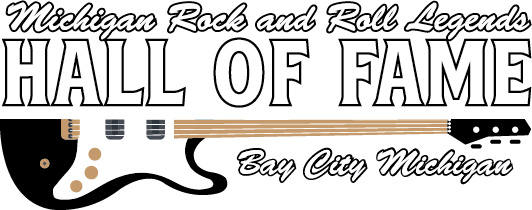Formed in the early 1960s during a period of uncertainty that gripped Michigan and the rest of the nation over the Cold War threat of a possible Russian nuclear attack; the band members would go on to weather three name changes and numerous shifts in both membership and musical direction. Being a little older than most of the bands playing in the teen music scene, they partied hard and used their unique brand of showmanship to become one of the most popular and frequently booked groups at Band Canyon and other teen clubs around the state.
For Ken Crandall, it all started in 1952 when his family lived at 906 Garfield St. in Bay City. His father brought home a ukulele one day and tried to teach him and his younger brother Bob how to play a few chords. The brothers found it difficult, and soon gave it up.
Years later, after moving to 303 Burns St. in Essexville, Ken noticed the ukulele in the top of a closet and started fooling around with those three chords (C, G, and D), but now with longer and stronger fingers, it was fun.
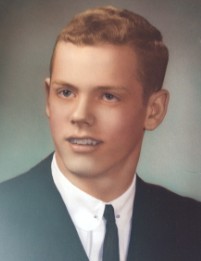 Ken Crandall
Ken Crandall
Crandall soon found an Essexville friend named Freddy Eurich who also had a ukulele. They formed a duo called Finger and Stringer and later advanced to playing a tenor banjo and acoustic guitar. They made their first public appearance at a local Optimist Club luncheon.
Jack Zientak was a classmate of Crandall’s at St. John’s High School in Essexville. “I was inspired to play guitar by the recordings of Duane Eddy, Chuck Berry, Bo Diddley, and Link Wray,” Zientak recalled. “After graduation, Crandall took me to a pawn shop in Saginaw and talked me into buying my first electric guitar, a Les Paul solid-body, just like his.”
The two started playing regularly in Zientak’s basement; Jack playing lead with Ken accompanying him on rhythm while they picked out the melodies of various instrumentals by The Ventures. Soon they teamed up with Jimmy Moeller, and the three played at Moeller’s Five and Dime to entertain the shoppers and also at the barber shop on Woodside Avenue in Essexville. “One day we played a party at Jeannie Anderson’s house on Pine Street,” Crandall recalled. “They passed a hat around for contributions. I thought, what, they’re going to pay us for having fun?”
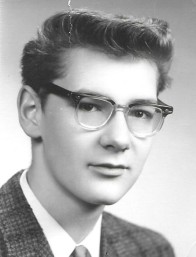 Jack Zientak
Jack Zientak
Shortly thereafter, Crandall and Zientak started frequenting a house on Farley Road, near Munger, Michigan, that became known to all who partied there as ‘the Pad’.
The word pad became popular in the late 1950s in beatnik slang to describe the place where one lived. The term ‘bachelor pad’ also gained popularity at this time in publications like Playboy magazine to describe upscale apartments featuring expensive furnishings, art on the walls, a shaker of martinis, and cool jazz on the stereo.
The Pad on Farley Road was none of these things. The house, which was out in the country and had no neighboring homes in the vicinity, was rented from a bar owner in Munger by former graduates of Bay City Central High School who used assumed names on the lease. In a recent interview, Central grad Tom “Benny” McGee remembered it well. “Nobody lived there,” he said. “It was strictly a party place. It was a small house with a TV and a record player that were donated by the guys who leased the house. There was one album, “Twist With The Ventures”, that was played over and over, and it became the unofficial theme music of the Pad.” 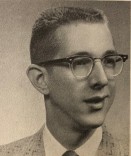 Tom "Benny" McGee
Tom "Benny" McGee
“There was one big rule,” McGee recalled. “You had to bring long neck beer bottles to drink at the Pad, and you had to leave them afterwards. At two cents per returnable bottle, there was enough beer drinking going on to pay most of the monthly rent as well as the heat and lights,” he said.
One of the bedrooms was allocated for beer bottle storage, and McGee, who worked at Ray’s Food Fair on Center Avenue at the time, would often bring in tubs of empties from the Pad to the store to cash in and help pay the bills. 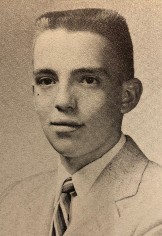 Tom Jarvis
Tom Jarvis
Crandall and Zientak met Tom Jarvis at the Pad. Jarvis, like Zientak, had just bought a new Fender Stratocaster guitar. They didn’t need three guitars so, against his father’s wishes, Crandall bought a Fender Precision bass with a big piggyback amp. With Zientak on lead, Jarvis on rhythm, and Crandall playing bass, they had the makings of an actual band.
“We moved our practice sessions out to the Pad and performed on Saturday nights in the tiny living room,” Crandall recalled. “The place was jam packed, wild, and crazy. It was our real-life version of Animal House with the ever-flowing beer, blasting guitars, dancing the twist, and general hell-raising.”
According to Crandall, they soon realized that they needed percussion. They asked around and were told that Bay City Central’s number one drummer was Ron Cunningham. They asked Cunningham to join them for a practice at the Pad on a Saturday afternoon before the weekly beer party. Cunningham, who hadn’t met Crandall, Zientak, or Jarvis before the rehearsal, recalled that his shoes stuck to the floor when he arrived to play. 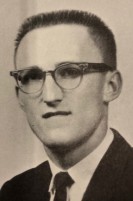 Ron Cunningham
Ron Cunningham
Cunningham’s drumming was influenced by the recordings of Gene Krupa, Sandy Nelson, and Cozy Cole, and his Slingerland drums meshed perfectly. “What a sweet sound to have lead guitar, rhythm, and bass along with Ron’s lively drumming.” Crandall remembered. Now all they needed was a great name for their fledgling band.
The world’s nuclear fears supplied the answer – ‘The Fallouts’. The term fallout was used to describe the cloud of radioactive dust that is created by a nuclear explosion that settles back down to earth afterwards, endangering the lives of those who survived the initial blast. It was a timely name inasmuch as Nikita Khrushchev, the leader of the Soviet Union, was considered a threat to unleash Russia’s nuclear arsenal on America during the Cold War between the two major powers.
This possibility caused a wave of paranoia in the United States that resulted in the construction of large public fallout shelters in cities, as well as smaller shelters dug into the back of individual homes or built into basements. President John F. Kennedy even had a secret one constructed on Peanut Island in Florida, near the Kennedy estate in Palm Springs where the President and his family would often spend time during the winter.
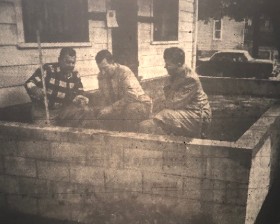 Chet Kelpinski (R) during the construction of the fallout shelter at his home
Chet Kelpinski (R) during the construction of the fallout shelter at his home
Civilian defense was also a big issue in Bay City area during the years 1960 and 1961. There were nearly one hundred stories in the Bay City Times dealing with the subject, including one on Chet Kelpinski, the Bay County Director of Civil Defense, that caught the eye of the band. Kelpinski was photographed for a story in the Bay City Times that highlighted the construction of a fallout shelter under the front porch of his home on Woodside Avenue; and The Fallouts came up with the novel idea of contacting him to help put together a group uniform that would be a good match with their new name.
The band told Kelpinski what they had in mind, and he was delighted with the idea of a young musical group promoting civil defense. He gave each member a white civil defense helmet with a logo and also a large number of informational brochures to pass out at their shows.
Donning their new helmets along with dark sunglasses and, according to Ken Crandall, “looking like dudes from outer space”, The Fallouts played their first official gig at the St. John’s High School J-Hop held in the Hughes School auditorium in Essexville. Sadly, there are no photos of the band in their CD outfits, but kids quickly spread the word about the crazy-looking new instrumental band in the area. It wasn’t long, however, before The Fallouts jettisoned their helmets and dark glasses and started performing in matching blazers and ties.  Ron Cunningham at a Bay City Central Homecoming Dance
Ron Cunningham at a Bay City Central Homecoming Dance
Crandall recalled that the band’s sets were made up mostly of Ventures’ tunes as well as instrumental versions of the hits of Chubby Checker and other Top 40 artists of the day. Santo & Johnny’s “Sleep Walk” was a popular slow song at the dances, and Ron Cunningham’s drumming, including his memorable solo on “Wipe Out” by The Surfaris, never failed to bring down the house. Cunningham was the star of The Fallouts during this time, sometimes throwing a drum stick on the floor in the middle of his routine and impressing the crowd by catching it on the bounce just in time for the next beat.
The Fallouts added a new member during a break at a post-football game dance at Bay City Central when Fritz Chapin asked the band if he could sit in on tenor sax for a few songs in their next set. Chapin’s sax turned out to be a perfect fit, and he was invited to join the band that very evening. Chapin was a highly trained musician who could read music and had attended Michigan’s elite music camp at Interlochen. He would later go on to major in music at the University of Michigan after leaving the band.
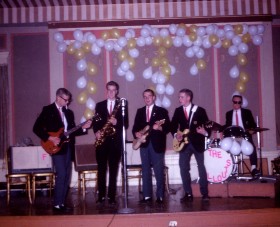 Fallouts at the Wenonah Hotel: (L to R) Jack Zientak, Fritz Chapin, Tom Jarvis, Ken Crandall, and Ron Cunningham
Fallouts at the Wenonah Hotel: (L to R) Jack Zientak, Fritz Chapin, Tom Jarvis, Ken Crandall, and Ron Cunningham
They also met Frank Tally at one of their gigs. Blessed with a great deal of energy and enthusiasm, he quickly assumed the role of the band’s manager. Tally was the son of a highly successful Bay City attorney and lived with his parents in a very large home on Center Avenue. The house had a full-size ballroom on an upper floor that wasn’t being used, and Tally had them store their equipment there between jobs and also use the space for practice sessions.
Tally initially started booking gigs for The Fallouts without asking for any compensation, but his value in lining up jobs soon became apparent, and the band started paying him 10% of the gross of each show. Tally lined up a wide variety of events in Bay City including private parties, wedding receptions, bars, and dances at local high schools, Delta College, and at the Wenonah Hotel.
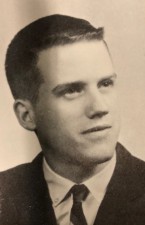 Frank Tally
Frank Tally
They were on a roll, but things changed quickly. The beer parties at the Pad came to an end after the landlord served an eviction notice, and The Fallouts crumbled when Tom Jarvis joined the National Guard, Jack Zientak had to have knee surgery, and Fritz Chapin left to attend college.
Crandall and Cunningham were invited to join Ron Monville and Danny Penkala in a band called The Del Rays that played regularly at The Shangri-La Bar in Bay City. Over a six-month period, they played at The Shangri-La and the Thunderbird Lounge in Flint on the 9:00 PM to 2:00 AM shift for $20 each. 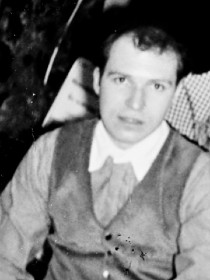 Gary Adamczyk
Gary Adamczyk
When Monville and Penkala decided to quit the grind, Crandall and Cunningham decided to form a new band. They brought Jack Zientak back and recruited Gary Adamczyk, a guitar instructor at Grinnell’s Music Store. Adamczyk, who was born in Kawkawlin and had learned to play guitar from his father, was a good fit in that he could sing, liked to drink beer, and enjoyed playing all kinds of music.
By 1964 the popularity of instrumental bands had started to wane. The arrival of The Beatles and the other British Invasion bands, as well as the popularity of American groups like the Beach Boys and the Kingsmen, had made vocals a virtual requirement for continued success. Luckily, the newly christened Del Raes found the perfect uninhibited front man it needed in the person of Ric Ziolkowski.
“My girlfriend and I crashed a wedding at a small hall off Midland Road near Auburn to get some free beer,” Ziolkowski recalled. “The Fallouts were playing and she told me that they needed a singer. After I had a few drinks, I got up on stage and sang 3 or 4 songs with them. Both Ron Cunningham and I were attending Delta College at the time, and Cunningham invited me to join the band when I saw him at school the following week,” Ziolkowski said.
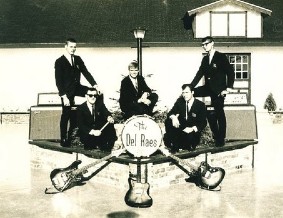 (L to R) Ken Crandall, Ron Cunningham, Ric Ziolkowski, Gary Adamczyk, Jack Zientak
(L to R) Ken Crandall, Ron Cunningham, Ric Ziolkowski, Gary Adamczyk, Jack Zientak
“Ric fit the Del Raes like a glove,” Crandall recalled. “Smiling, laughing, acting like a goofy bastard, not giving a shit about anything; but he could sing your pants off! It was a match made in heaven,” Crandall said. “He was our guy, and now we were clicking on all cylinders.”
Soon after, they discovered that the original Del Rays had been scheduled to play the very first Roll-Air Battle of the Bands in the summer. Seizing the opportunity, they decided to play the gig at Roll-Air as a new version of the Del Rays by simply changing the spelling to ‘Del Raes’.
It was at Roll-Air, an open-air venue located on State Park Drive in Bay City, that The Del Raes firmly established themselves as the area’s top group. The weekly Battle of the Bands events held during the summer of 1964 were hosted by WKNX DJs Bob Dyer and Dick Fabian.
"Fabian was a wild man, a lot of fun to be around. Bob Dyer was a little more business-like but also a great guy," Ron Cunningham recalled. "If you won, the band came back the following week and competed against a new group of bands."
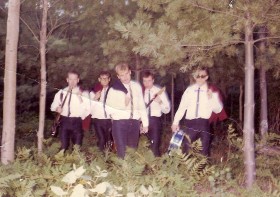 Del Raes: (L to R) Crandall, Zientak, Ziolkowski, Adamczyk, and Cunningham
Del Raes: (L to R) Crandall, Zientak, Ziolkowski, Adamczyk, and Cunningham
“Each competing band was given 30 minutes to do their best stuff, and the winner was determined by judges after counting the ballots that were given to ticket buyers at the gate,” Crandall said. “We won the event multiple times, and it was great to hear Bob Dyer announce us as the winner week after week on WKNX,” he recalled. “During our final appearance, we threw bananas with ‘Del Raes” written on them into the crowd while playing the song ‘Mickey’s Monkey’, and the kids picked them up and threw them right back at us,” Crandall recalled.
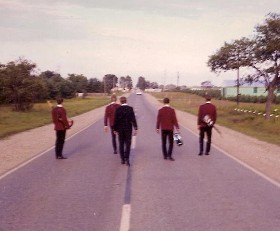 On the road in N. Michigan
On the road in N. Michigan
The band’s success at Roll-Air led to more gigs, often times with Dyer and Fabian. The Del Raes did not have a manager but, according to Jack Zientak, Ron Cunningham handled most of the business matters. “He knew the club owners and DJs, set up the gigs, and signed most of the checks,” Zientak said.
“The Del Raes played for a DJ named Ted LaFave out in the Thumb, as he had a regular place for dances,” Cunningham recalled. “We also played at the Village Pump in Bridgeport and at The Tradewinds, located on the southeast corner of Euclid and State Park Drive.”
The band also appeared a number of times at the Golden Glow Ballroom. The large venue, located in Saginaw County, was originally constructed in 1924. After it was purchased in 1962 by Bonnie Firestein, it became one of the Midwest’s premier entertainment venues, drawing 1,000 music fans to dances with local groups and to see national acts like Chubby Checker and Jan & Dean.
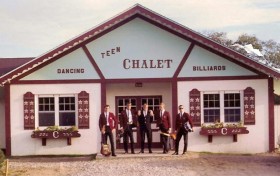 Del Raes at the Teen Chalet in Gaylord, Michigan
Del Raes at the Teen Chalet in Gaylord, Michigan
The Del Raes became a big hit at Daniel’s Den in Saginaw as well. The venue was a former movie theater that had been converted into a teen club by owner Frank Patrick. “It was cool to see our name on the big marquee,” Crandall recalled. “At showtime, they would slowly open the red velvet stage curtain and we’d blast away at a full house of dancing, partying kids. We three guitar guys did a choreography while playing, doing a box step in unison. During breaks, the curtain would close and we’d go out back in the parking lot and drink beer.”
“I really like playing Daniel’s Den,” Gary Adamczyk remembered. “The most fun I had was when we played “House Of The Rising Sun”. We had taken branches from the back of the venue and stuck them in butcher’s coats that we brought that were covered in blood. We stood on tables when we played our guitars and people were screaming,” he said. “It was so much fun!”
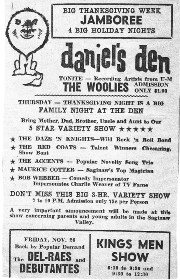
The curtain allowed the Del Raes the opportunity to surprise the audience in different ways, including having Ziolkowski’s sister, Nona, appear on stage as a go-go dancer or to push her brother around in a large baby buggy while he sang The Newbeats’ hit, “Bread And Butter”.
“We backed up Sonny and Cher when they appeared at Daniel’s Den in 1965, and owner Frank Patrick wanted to sign the Del Raes as the house band,” Ron Cunningham recalled. “But part of the agreement was that we couldn’t play in a 50-mile radius from the club. Because of that, we turned him down.”
“The Del Raes also opened for The Byrds at Daniel’s Den when they appeared there on December 5, 1965,” Ziolkowski remembered. “Chris Hillman’s birthday had been the day before, and a fan had brought a birthday cake to the green room downstairs which David Crosby promptly destroyed before anyone could eat it.”
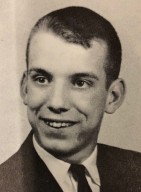 Roger Cady
Roger Cady
The band underwent a significant change in December of 1964 when group founder Ken Crandall left The Del Raes to get married. Crandall sold all of his equipment and moved to Indiana. He was replaced on bass by Roger Cady, a Bay City speed skating champion whose father was a music professor at Delta College.
The summer of 1965 saw the opening of the Band Canyon teen club in Bay City. The Del Raes made their debut at the club, owned by local businessmen A. J. LaMarre and Bill Kehoe, on August 23, 1965. Being one of the area’s most popular bands, they were booked again at the club for three consecutive weeks on September 5th, 12th, and 19th.

On September 25th they opened for Bobby Goldsboro at Band Canyon and then backed the singer who was touring behind his latest Top 40 single, “Voodoo Woman”.
The Del Raes played more times at Band Canyon in 1965 than any other band, adding five more dates in October, one in November, and then capping off the year by performing at Band Canyon’s first New Year’s Eve Party on December 31st. It was during this time that the band signed a management deal with Bill Kehoe and Delta Promotions.
The music scene had undergone a dynamic transformation in 1965, however, with the emergence of folk rock. Basically a melding of the music of the folk movement of the early 60s with the sound and styles of the Beatles and other British Invasion groups, the music charts were now being topped by The Byrds, Bob Dylan, Simon & Garfunkel, the Lovin’ Spoonful, and Barry McGuire – all former folk artists who were now growing their hair long and using electric instrumentation. The music, the uniforms, and even the name Del Raes was starting to seem a little old-fashioned.
1966 brought some more major changes in the band. The Del Raes played two more gigs at Band Canyon at the start of the year, the final one on January 28th. Shortly thereafter, all of the band’s new lineup were photographed with the owner of the Herter’s Music Center for a Bay City Times’ story on the popularity of guitars. Roger Cady announced that the Del Raes had changed their name to The Shepherds because he was quoted as saying, “the name seemed to fit more with the ‘folk rock’ we are doing now, instead of the ‘rock and roll’ we played under the old name.”
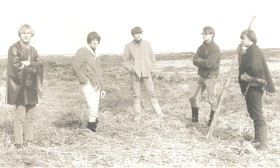 The Shepherds: (L to R) Jerry Huiskens, Roger Cady, Mike Ryan, Jack Zientak, Ric Allan
The Shepherds: (L to R) Jerry Huiskens, Roger Cady, Mike Ryan, Jack Zientak, Ric Allan
The Shepherds’ new lineup was composed of Mike Ryan on drums, Jerry Huiskens and Jack Zientak on guitars, Roger Cady on bass and vocals, and Ric Ziolkowski, who was now using the stage name ‘Ric Allan’, on vocals and guitar. Heavily influenced by The Byrds and Bob Dylan, they had become a folk rock band. Their appearance changed as well; the band uniforms were gone, and it was now long hair, ponchos, jeans, and boots.
“Ron Cunningham was fired by The Shepherds,” recalled Jack Zientak. “He was going to Central Michigan University full-time and working part-time at the Carpet Center, and Mike Ryan had begun replacing him on drums at gigs. When the band would get together at Roger Cady’s basement to rehearse and work on arrangements, Ron would be sleeping and not paying attention. Then there was the fact that ‘Wipeout’ and drum solos didn’t fit into The Shepherds’ new direction,” Zientak said.
Cunningham was also facing the draft, but he was able to get into the Army Reserve in Saginaw to avoid being drafted into the Army and risk being sent to Vietnam. The price, however, was a six-year commitment.
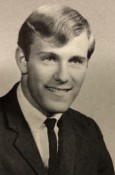 Jerry Huiskens
Jerry Huiskens
Gary Adamczyk also left the band at this time to join another group called The Tempests. His replacement on guitar was Jerry Huiskens. Huiskens was from Essexville, and he had formed a band called The Invictas that had competed with The Del Raes at Roll-Air’s Battle of the Bands in 1964. Huiskens was the only member of the band who was married and had a child.
Deb & Jo’s weekly teen music column in the Saginaw News on February 12th officially announced the Del Raes’ name change to the band’s Saginaw fans. The article stated: “They’ve changed their name to The Shepherds and things are beginning to happen! They recently cut some discs. These cuts will be out soon for all to hear.”
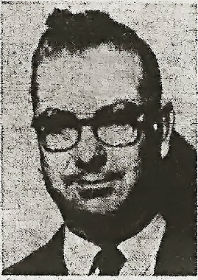 Bill Kehoe - Delta Promotions
Bill Kehoe - Delta Promotions
“Bill Kehoe, our manager, pursued the record deal for us,” Jerry Huiskens recalled. “Bill made a deal with Impact Records and we were all in agreement.” The Impact label was owned by music business veteran Harry Balk who had enjoyed success in the record business in the 50s and 60s with such well-known artists as Little Willie John, Del Shannon, and Johnny and The Hurricanes. Balk had started the Impact label in Detroit in 1965 and was interested in signing new artists. According to Jack Zientak, Balk sat in on the Shepherds’ recording session.
“The recording session seemed long to us,” Huiskens recalled. “and the drive to Detroit and back was over five hours at that time. I remember we all had retakes for one thing or another, as recording usually does. “We were new to it,” he said, “and I had bought a new electric 12-string guitar before the session and was using it to get the Byrds’ sound on the record; but it kept going out of tune.”
Overall, it was a fun experience being in a professional recording studio for the first time. The Shepherds recorded four songs during the session. Two were selected to be the band’s first single. The A-side was a folk rock version of “When Johnny Comes Marching Home”, a Civil War-era song over 100 years-old that was speeded up and made to sound like The Byrds, compliments of Zientak’s and Huiskens’ twelve-string guitars and the band’s vocal harmonies. Its anti-war message was right in line with the growing number of protests on college campuses around the country over America’s escalating involvement in the Vietnam conflict.
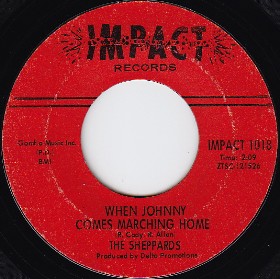
Strangely enough, the songwriting credit for "When Johnny Comes Marching Home" was awarded to Roger Cady and Ric Allan even though the song had been written by Irish-American bandleader Patrick Gilmore and published back in 1863. The B-side was an original song written by Mike Ryan and Cady called “Poor Man’s Thing”.
The Shepherds returned to Bay City in triumph, and played the songs on their new single at their first Band Canyon gig under their new name on April 13th. They were back at Band Canyon on April 30th and then again on May 29th as part of a Honda 50 giveaway promotion through Linwood Cycle Sales.
Their Impact single remained unreleased, however. In a stroke of bad luck for The Shepherds, “Oh How Happy”, a recording from a blue-eyed soul group from Livonia, called The Shades Of Blue, had become a national hit in the spring. The small Impact label put all of its efforts in promoting “Oh How Happy”, which had been written by Edwin Starr, and then to recording an album by The Shades Of Blue to be released in its wake. As a result, the release of The Shepherds’ single was put on the back burner.
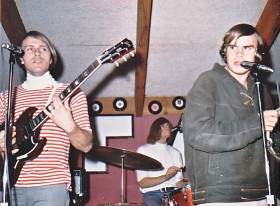 Huiskens, Ryan, and Allan at Mt. Holly
Huiskens, Ryan, and Allan at Mt. Holly
In the meantime, the band continued to play at Band Canyon and at the dances at Mt. Holly that were hosted by Bob Dell. "Mt Holly was a great place to play," Ric Allan recalled. "One night we opened for The Orlons and we got to ski for free."
“The Shepherds were clueless as far as public relations was concerned,” Jack Zientak recalled. “Both Bob Dell from WTAC and Bob Dyer of WKNX wanted the band to sign a performance contract for regular gigs but we declined in light of the 45 we thought was coming out.”
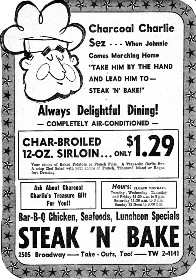
“Because of the success of “Oh How Happy” our single was delayed for nearly a year,” Jerry Huiskens recalled. “Bill Kehoe also owned the Steak ‘N’ Bake restaurant on Broadway, and after he became the Shepherds’ manager, I worked there part-time. When the record finally came out in 1967, the restaurant had large ads in the Bay City Times with the words - Charcoal Charlie Sez… ‘When Johnny Comes Marching Home’ take him by the hand and lead him to – Steak ‘N’ Bake!” – “I was Charcoal Charlie,” Huiskens recounted.
Unfortunately, by 1967, the folk rock sound that The Byrds introduced in 1965 was no longer on the cutting edge, and “When Johnny Comes Marching Home” sounded a little dated despite its anti-war sentiment. To add insult to injury, the band’s name was misspelled as The Sheppards on the 45. The record received some airplay on local radio stations but soon sunk without a trace.
Mike Ryan left the band at this time and was replaced on drums by Lanny Avery. “After a time, we got frustrated and stopped playing for a while,” Huiskens remembered. “When the record finally came out, we tried to get back together and play some gigs, but by then we each wanted to pursue things in our own lives and the Shepherds broke up.”
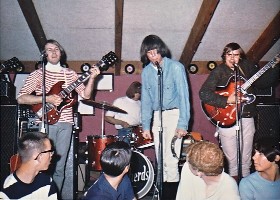 (L to R) Huiskens, Ryan, Cady, and Allan at Mt. Holly
(L to R) Huiskens, Ryan, Cady, and Allan at Mt. Holly
Cady, Allan, and Avery all enrolled at Western Michigan University which enabled them to obtain a student deferment from the draft. Huiskens and his family moved to Phoenix, Arizona, and Zientak would begin what would become a long career at Consumer’s Power.
It all seemed to end rather quickly; but the group of young musicians who made up The Fallouts, The Del Raes, and The Shepherds had a long and interesting run. Looking back on those glory days of the 1960s, Ron Cunningham had this to say about the Del Raes: “It was fun. The whole ride was fun, playing in front of hundreds of kids, the curtains opening at Daniel’s Den, and then the kids excited to see and hear what you play. What a thrill! There were probably better bands than the Del Raes – we didn’t write any original music or record any singles; but the key to our success was the showmanship of the band on stage. That’s what got the kids excited.”
